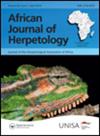阿尔及利亚东北部埃多夫半岛1883年Salamandra algira Bedriaga的栖息地结构和存在
IF 0.9
4区 生物学
Q3 ZOOLOGY
引用次数: 4
摘要
摘要本研究探讨了阿尔及利亚东北部埃多夫半岛的生境特征对algira Salamandra存在的影响。在该地区,在冬末和春季对33个地点进行了为期三年的调查。Salamandra algira在其中16个地点出现,17个地点缺席。根据这些样地的宏观生态(气候、地形)和生境结构(密度、高度、郁闭度和木本植物多样性)进行特征分析。分析表明,平均温度、地形、木本植物密度、高度和冠层盖度是造成褐藻存在和不存在地点差异的主要原因。黑桫椤占据的生境主要为中地中海和上地中海森林热型,以canariensis野生栎(Quercus canariensis wild)为主。栎(Quercus suber L.)。相比之下,在地中海热区森林中只在一个地点证实了褐藻的存在。这表明,在Edough地区,软木橡树林的嗜热相与热地中海地层之间的过渡可能决定了S. algira的下限。本文章由计算机程序翻译,如有差异,请以英文原文为准。
Habitat structure and presence of Salamandra algira Bedriaga, 1883 in the Edough Peninsula, north-eastern Algeria
Abstract This study examined the role of habitat characteristics on the presence of Salamandra algira in the Edough Peninsula, north-eastern Algeria. In this region, 33 sites were surveyed over the late winter and spring for a period of three years. Salamandra algira was present at 16 of these sites and absent from 17. These sites were characterized based on parameters related to their macroecology (climate, topography) and habitat structure (density, height, canopy closure and diversity of woody plants). Our analyses showed that mean temperature, topography, woody plant density and height and canopy cover contributed most to the explaining differences between sites where S. algira was present and where it was absent. Most of the sites occupied by S. algira were supra- and meso-Mediterranean forest thermotypes and were dominated by deciduous/evergreen oak trees (Quercus canariensis Willd. and Quercus suber L.). In contrast, the presence of S. algira in thermo-Mediterranean forest was only confirmed in one location. This suggests that the transition between the thermophilic facies of the cork oak forest and the thermo-Mediterranean formations possibly determines the lower limits of S. algira in the region of Edough.
求助全文
通过发布文献求助,成功后即可免费获取论文全文。
去求助
来源期刊

African Journal of Herpetology
ZOOLOGY-
CiteScore
3.00
自引率
6.70%
发文量
15
审稿时长
>12 weeks
期刊介绍:
African Journal of Herpetology (AJH) serves as an outlet for original research on the biology of African amphibians and reptiles. AJH is an interdisciplinary journal that publishes original articles and reviews from diverse fields and disciplines, such as conservation, phylogenetics, evolution, systematics, performance, physiology, ecology, behavioural ecology, ethology, and morphology.
The Journal publishes two issues a year. There are no page charges .
 求助内容:
求助内容: 应助结果提醒方式:
应助结果提醒方式:


